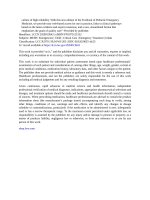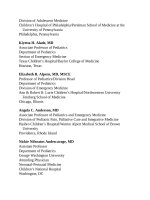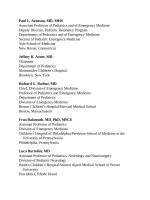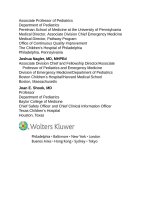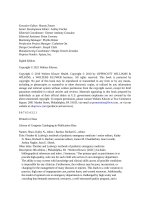Pediatric emergency medicine trisk 2725 2725
Bạn đang xem bản rút gọn của tài liệu. Xem và tải ngay bản đầy đủ của tài liệu tại đây (102.55 KB, 1 trang )
CLINICAL PEARLS AND PITFALLS
Tumor lysis syndrome can occur in patients who have undergone CAR-T
cell therapy and is managed similarly to other oncology patients with this
complication.
Cytokine release syndrome (CRS) presents with fever and multi-system
organ failure and can mimic the presentation of septic shock.
Neurotoxicity related to CAR-T cell therapy includes nonspecific
neurologic symptoms but can progress to coma.
Current Evidence
CAR-T cell therapy uses a patient’s genetically modified T cells to express anticancer surface receptors. Once developed, the CAR-T cells are infused back into the
patient where they encounter target antigen, leading to rapid proliferation and
release of cytokines. Over the subsequent 28 days, these patients are at high risk for
cytokine-mediated toxicities, particularly after the first 2 weeks, and can present
acutely ill. Though this cellular therapy is not universally available, it is becoming
more accessible and the ED clinician should be aware of this potential complication
in patients who have undergone this therapy.
Clinical Considerations
Clinical Recognition
Patients with CRS may appear to be in septic shock. Fever, chills, myalgias are
typically the earliest symptoms, and when severe are followed by tachycardia,
hypotension and signs of capillary leak including localized edema, pleural or
pericardial effusions, altered mental status, and shock. Neurotoxicity may occur
concurrent with CRS and includes nonspecific symptoms including headache,
confusion, and tremor. Severe neurotoxicity symptoms include hallucinations,
seizures, and signs of cerebral edema. Patients can progress to coma.
Clinical Assessment
As with any critically ill oncology patient, the stabilization of airway, breathing, and
circulation is the highest priority. Institutions using CAR-T cell therapy will likely
have protocols in place for the initial response to patients who present after CAR-T
cell infusion, and initial assessment and management should be approached in
conjunction with oncologic consultation. Laboratory assessment of organ function
including a CBC, electrolytes and management of renal function, as well as
measurement of inflammatory markers including ferritin and CRP. Neuroimaging
and CSF examination may be required in patients with neurotoxicity.
